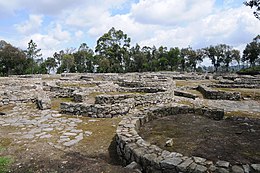
Back Cividade de Terroso Catalan Cividade de Terroso Spanish Terrosoko kastroa Basque Cividade de Terroso Galician Cividade de Terroso Italian Cividade de Terroso Portuguese Городище Террошу Ukrainian


Cividade de Terroso was an ancient city of the Castro culture in North-western coast of the Iberian Peninsula, situated near the present bed of the Ave river, in the suburbs of present-day Póvoa de Varzim, Portugal.
Located, in the heart of the Castro region,[1] the cividade played a leading role in the early urbanization of the region in the early 1st millennium BC, as one of the oldest, largest and impregnable castro settlements. It was important in coastal trading[2] as it was part of well-established maritime trade routes with the Mediterranean. Celtic and later Carthaginian influence a well-known, it was eventually destroyed after the Roman conquest in 138 BC. The city's ancient name is not known with certainty but it was known during the Middle Ages as Civitas Teroso (The City of Terroso). it was built at the summit of Cividade Hill, in the suburban area of Terroso, less than 5 km from the coast, near the eastern edge of modern Póvoa de Varzim.
Beyond the main citadel, three of Cividade de Terroso's outposts are known: Castro de Laundos (the citadel's surveillance post), Castro de Navais (away from the citadel, a fountain remains to this day), and Castro de Argivai (a Castro culture farmhouse in the coastal plain). Cividade de Terroso is located just 6,3 km from Cividade de Bagunte both in the North bank of the Ave river.
© MMXXIII Rich X Search. We shall prevail. All rights reserved. Rich X Search